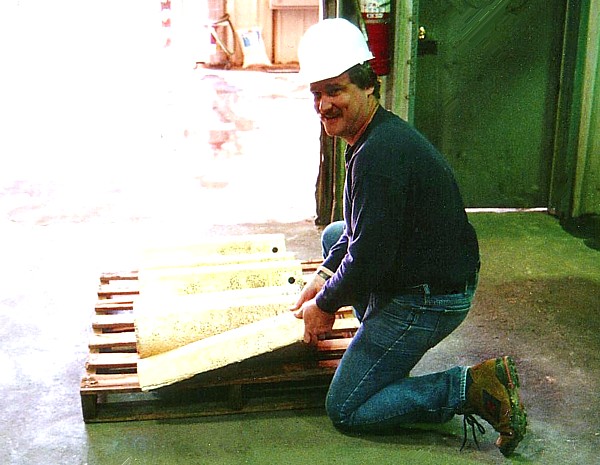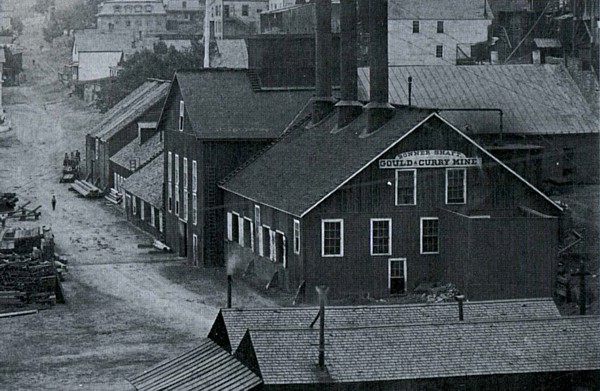
 |
Silver Bullion Beyond Belief |
.
| In the early
1860s, Nevada's rich gold and silver deposits were pumping out wealth in unbelievable amounts.
Interest across the nation in these wonderful treasure troves of bullion was high. Because
Twain was living in Virginia City, and working as a reporter, he had a special opportunity
to see the riches of these mines close up. Here are his comments on the subject: ----------- Since I desire, in this chapter, to say an instructive word or two about the silver-mines, the reader may take this fair warning and skip, if he chooses. The year 1863 was perhaps the very top blossom and culmination of the "flush times." Virginia swarmed with men and vehicles to that degree that the place looked like a very hive - that is when one's vision could pierce through the thick fog of alkali dust that was generally blowing in summer. I will say, concerning this dust, that if you drove ten miles through it, you and your horses would be coated with it a sixteenth of an inch thick and present an outside appearance that was a uniform pale-yellow color, and your buggy would have three inches of dust in it, thrown there by the wheels. The delicate scales used by the assayers were enclosed in glass cases intended to be air-tight, and yet some of this dust was so impalpable and so invisibly fine that it would get in, somehow, and impair the accuracy of those scales. Speculation ran riot, and yet there was a world of substantial business going on, too. All freights were brought over the mountains from California (one hundred and fifty miles) by pack-train partly, and partly in huge wagons drawn by such long mule-teams that each team amounted to a procession, and it did seem, sometimes, that the grand combined procession of animals stretched unbroken from Virginia to California. Its long route was traceable clear across the deserts of the territory by the writhing serpent of dust it lifted up. By these wagons, freights over that hundred and fifty miles were $200 a ton for small lots (same price for all express matter brought by stage), and $100 a ton for full loads. One Virginia firm received one hundred tons of freight a month, and paid $10,000 a month freightage. In the winter the freights were much higher. All the bullion was shipped in bars by stage to San Francisco (a bar was usually about twice the size of a pig of lead and contained from $1,500 to $3,000, according to the amount of gold mixed with the silver), and the freight on it (when the shipment was large) was one and a quarter per cent. of its intrinsic value. So, the freight on these bars probably averaged something more than $25 each. Small shippers paid two per cent. There were three stages a day, each way, and I have seen the outgoing stages carry away a third of a ton of bullion each, and more than once I saw them divide a two-ton lot and take it off. However, these were extraordinary events. ^1 Two tons of silver bullion would be in the neighborhood of forty bars, and the freight on it over $1,000. Each coach always carried a deal of ordinary express matter besides, and also from fifteen to twenty passengers at from $25 to $30 a head. With six stages going all the time, Wells, Fargo & Co.'s Virginia City business was important and lucrative. [Footnote 1: Mr. Valentine, Wells-Fargo's agent, has handled all the bullion shipped through the Virginia office for many a month. To his memory - which is excellent - we are indebted for the following exhibit of the company's business in the Virginia office since the first of January, 1862: From January 1st to April 1st, about $270,000 worth of bullion passed through that office; during the next quarter, $570,000; next quarter, $800,000; next quarter, $956,000; next quarter, $1,275,000; and for the quarter ending on the thirtieth of last June, about $1,600,000. Thus in a year and a half, the Virginia office only shipped $5,330,000 in bullion. During the year 1862 they shipped $2,615,000, so we perceive the average shipments have more than doubled in the last six months. This gives us room to promise for the Virginia office $500,000 a month for the year 1863 (though perhaps, judging by the steady increase in the business, we are underestimating, somewhat). This gives us $6,000,000 for the year. Gold Hill and Silver City together can beat us - we will give them $10,000,000. To Dayton, Empire City, Ophir, and Carson City, we will allow an aggregate of $8,000,000, which is not over the mark, perhaps, and may possibly be a little under it. To Esmeralda we give $4,000,000. To Reese River and Humboldt $2,000,000, which is liberal now, but may not be before the year is out. So we prognosticate that the yield of bullion this year will be about $30,000,000. Placing the number of mills in the territory at one hundred, this gives to each the labor of producing $300,000 in bullion during the twelve months. Allowing them to run three hundred days in the year (which none of them more than do), this makes their work average $1,000 a day. Say the mills average twenty tons of rock a day, and this rock worth $50 as a general thing, and you have the actual work of our one hundred mills figured down "to a spot" $1,000 a day each, and $30,000,000 a year in the aggregate. - Enterprise. [A considerable overestimate. - M.T.]] |
.-g.-. | |
All along
under the center of Virginia and Gold Hill, for a couple of miles, ran the great Comstock
silver-lode - a vein of ore from fifty to eighty feet thick between its solid walls of
rock - a vein as wide as some of New York's streets. I will remind the reader that in
Pennsylvania a coal vein only eight feet wide is considered ample. Of
course these mines cave in, in places, occasionally, and then it is worth one's while to
take the risk of descending into them and observing the crushing power exerted by the
pressing weight of a settling mountain. I published such an experience in the Enterprise,
once, and from it I will take an extract: |
. | |
An Hour in
the Caved Mines. - We journeyed down into the Ophir mine, yesterday, to see the
earthquake. We could not go down the deep incline, because it still has a propensity to
cave in places. Therefore we traveled through the long tunnel which enters the hill above
the Ophir office, and then by means of a series of long ladders, climbed away down from
the first to the fourth gallery. Traversing a drift, we came to the Spanish line, passed
five sets of timbers still uninjured, and found the earthquake. Here was as complete a
chaos as ever was seen - vast masses of earth and splintered and broken timbers piled
confusedly together, with scarcely an aperture left large enough for a cat to creep
through. Rubbish was still falling at intervals from above, and one timber which had
braced others earlier in the day, was now crushed down out of its former position, showing
that the caving and settling of the tremendous mass was still going on. We were in that
portion of the Ophir known as the "north mines." Returning to the surface, we
entered a tunnel leading into the Central, for the purpose of getting into the main Ophir.
Descending a long incline in this tunnel, we traversed a drift or so, and then went down a
deep shaft from whence we proceeded into the fifth gallery of the Ophir. From a side-drift
we crawled through a small hole and got into the midst of the earthquake again - earth and
broken timbers mingled together without regard to grace or symmetry. A large portion of
the second, third, and fourth galleries had caved in and gone to destruction - the two
latter at seven o'clock on the previous evening. Returning
along the fifth gallery, we struck the safe part of the Ophir incline, and went down it to
the sixth; but we found ten inches of water there, and had to come back. In repairing the
damage done to the incline, the pump had to be stopped for two hours, and in the mean time
the water gained about a foot. However, the pump was at work again, and the flood-water
was decreasing. We climbed up to the fifth gallery again and sought a deep shaft whereby
we might descend to another part of the sixth, out of reach of the water, but suffered
disappointment, as the men had gone to dinner, and there was no one to man the windlass.
So, having seen the earthquake, we climbed out at the Union incline and tunnel, and
adjourned, all dripping with candle-grease and perspiration, to lunch at the Ophir office.
Twain's comments on the Sutro tunnel are interesting, although it was completed mostly as planned, it never yielded the wealth it was supposed to. The mines fought with the Sutro company and by the time it was completed, they were mostly working levels deeper than the Sutro tunnel reached. Boom days were renewed in the 1870s, but it was due to the fantastic bonanza find in the hanging wall deposits of the Consolidated Virginia and California Mines. Mark Twain’s stories about his experiences prospecting in
the west, including many more humorous tales of his adventures can be found in his book: ROUGHING IT |
. |
 |
The author is shown with over one ton of Nevada silver bullion. In addition to a ton of silver, these white metal bricks contain more than 20 pounds of Nevada Gold as well. This bullion was taken from the Humboldt Mountain range where Mark Twain prospected with his companions. |
 |
This is a photo of one of the shafts of the Gould and Curry Mine in Virginia City. It was from the 1200 foot level of this mine that a drift was run into the hanging wall of the Consolidated Virginia mine and the great hanging wall bonanza was discovered - but that great body of ore was actually discovered a couple years after Mark Twain wrote "Roughing It". |
Please note that the author, Chris Ralph, retains all copyrights to this entire document
and it may not be reproduced, quoted or copied without permission.
About OUR Nevada Turquoise
All of the turquoise sold on this site is mined from our own mines in Nevada. No one can offer a stronger assurance of the origin and natural nature of gem turquoise than we can for our turquoise - after all we are the ones who pulled it from the ground. We offer a free virtual tour of our mines, so you can see the real "Nevada Outback" conditions where our turquoise originated. Come a see what mining turquoise in Nevada is all about - CLICK HERE.